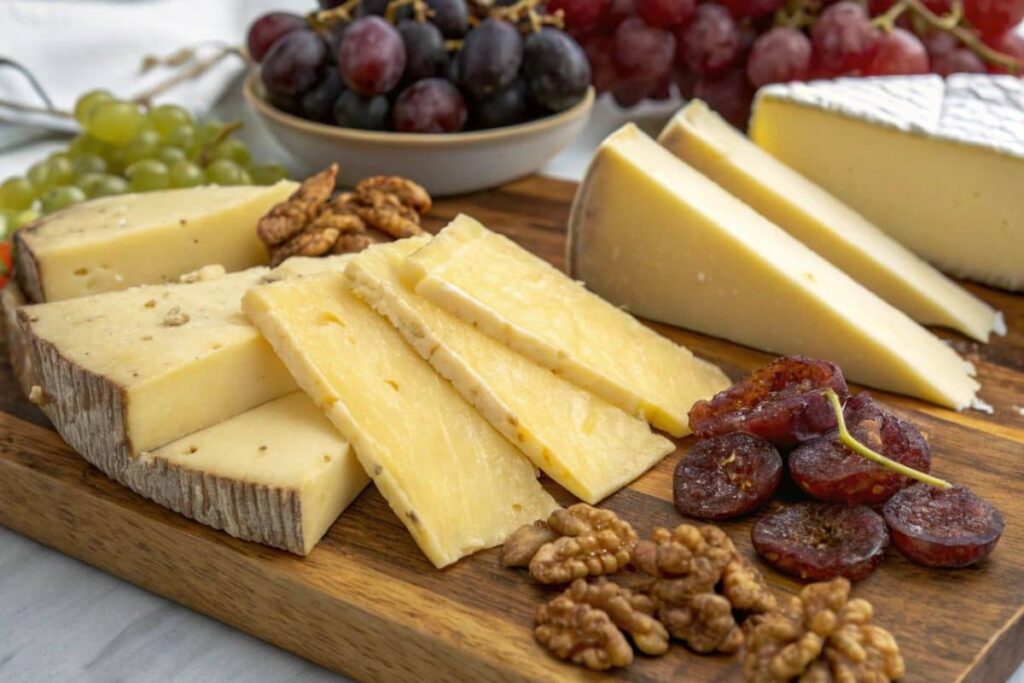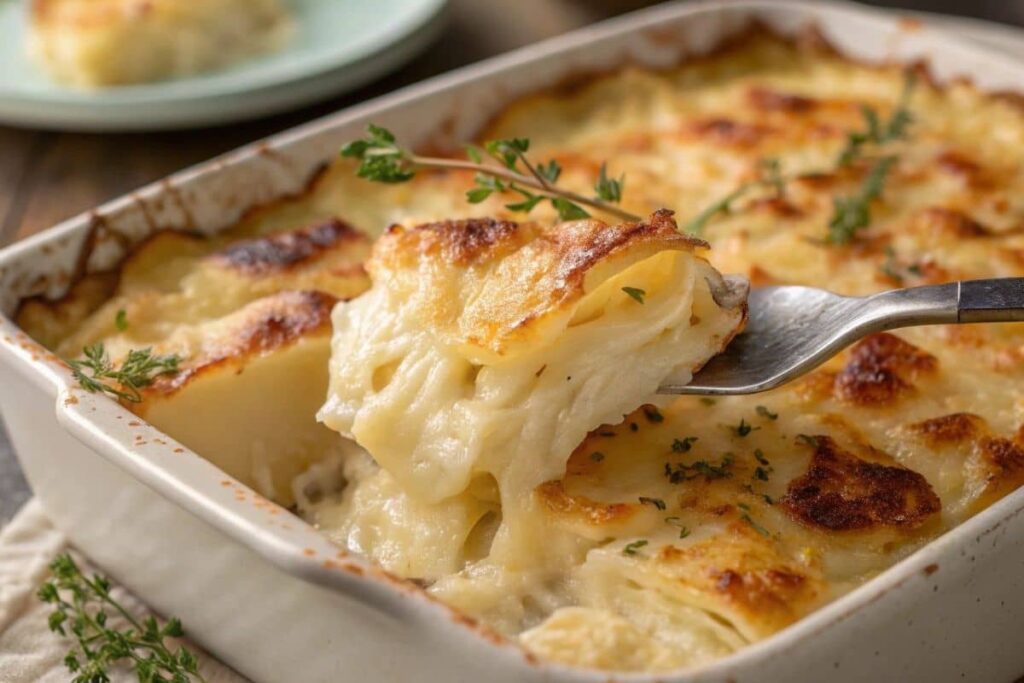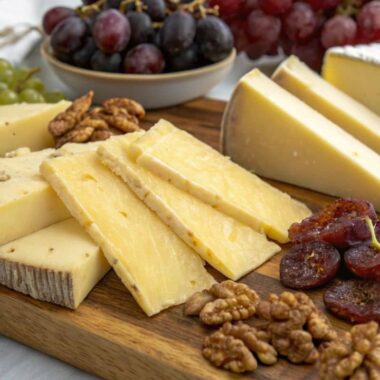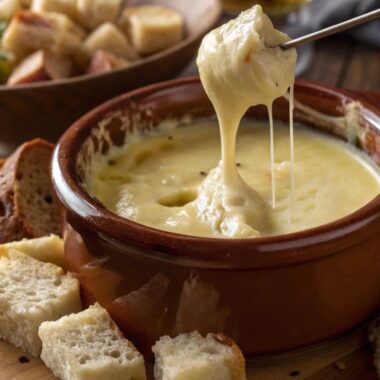Gruyere cheese—just the name sounds fancy, doesn’t it? 🧀 But don’t let that intimidate you! This Swiss superstar is more than just a cheese; it’s a game-changer in the kitchen. Whether you’ve had it melted on fondue, layered in a grilled cheese sandwich, or grated over scalloped potatoes, Gruyere always brings its A-game. So, let’s dive deep and explore what makes Gruyere cheese so special, shall we?
Table of Contents

Introduction to Gruyere Cheese
What Is Gruyere Cheese?
Gruyere is a hard cheese that hails from Switzerland, specifically the region of Gruyères (hence the name). Known for its creamy, nutty flavor and smooth texture, this Swiss delight melts like a dream. If you’ve ever tasted fondue or French onion soup, chances are this versatile cheese was the star ingredient. Pretty impressive, huh?
A Brief History of Gruyere Cheese
Did you know this iconic Swiss cheese has been around for centuries? In fact, it’s been produced since the 12th century! Imagine that—a timeless delight people have been savoring for over 900 years. It all started in the Swiss town of Gruyères, where dairy farmers used milk from cows grazing on lush Alpine pastures to craft this masterpiece. Talk about farm-to-table before it was trendy!
Why Is Gruyere Cheese So Popular?
Let’s be honest—this cheese’s popularity isn’t just about its taste (although that’s a big part of it). It’s also about how versatile it is. Need something that melts beautifully? It’s got your back. Want a perfect pairing for wine? This Swiss classic says, “I’m in.” Plus, it’s a staple in so many iconic dishes like fondue, quiche, and even mac and cheese. Honestly, what’s not to love?
How Is Gruyere Cheese Made?
Traditional Methods of Production
The process of making this Swiss classic is both an art and a science. Fresh cow’s milk is heated and mixed with rennet to form curds. These curds are cut into small pieces and cooked until they achieve the perfect texture. The mixture is then pressed into molds, salted, and left to age for several months—or even years! The longer it ages, the richer and more complex its flavor becomes.
Ingredients Used in Gruyere Cheese
Gruyere cheese is made with simple, wholesome ingredients:
| Ingredient | Purpose |
|---|---|
| Cow’s Milk | Main ingredient for rich flavor |
| Rennet | Helps coagulate the milk |
| Salt | Enhances taste and aids preservation |
| Bacterial Cultures | Develops the cheese’s unique flavor |
Simple, right? But don’t let that fool you—it’s the precision and care that go into the process that make Gruyere truly exceptional.
Aging Process and Its Impact on Flavor
One of the coolest things about Gruyere is how much its flavor changes as it ages. Younger Gruyere (about 3-5 months old) is mild, creamy, and slightly sweet. As it ages (6-12 months or more), it develops a stronger, nuttier, and more complex taste. Think of it like a fine wine—it only gets better with time!
The Unique Flavor Profile of Gruyere Cheese
How Gruyere Compares to Other Cheeses
If you’re wondering how Gruyere stacks up against other cheeses, here’s the scoop: it’s a bit milder than Parmesan but nuttier than Cheddar. Its smooth melting quality sets it apart from Swiss cheese, which can sometimes feel rubbery. Basically, Gruyere is the Goldilocks of cheeses—just right. 😊
Variations in Taste Based on Aging
As we mentioned earlier, the flavor of Gruyere evolves as it ages. Younger Gruyere is perfect for dishes where you want a subtle touch, like a creamy pasta sauce. Older Gruyere, with its bold and nutty notes, shines in recipes like French onion soup or quiches. Want the best of both worlds? Try blending young and aged Gruyere for an explosion of flavor! 🚀
Nutritional Information About Gruyere Cheese
Macronutrient Breakdown: Protein, Fat, and Carbs
Is Gruyere healthy? Let’s break it down. Here’s what you’ll typically find in a 1-ounce (28g) serving:
| Nutrient | Amount |
|---|---|
| Calories | 117 |
| Protein | 8g |
| Fat | 9g |
| Carbs | 0g |
| Calcium | 202mg (20% DV) |
With its high protein and calcium content, Gruyere is not just tasty—it’s also nutritious. However, like all good things, moderation is key!
Vitamins and Minerals in Gruyere Cheese
Gruyere is packed with essential nutrients like calcium, vitamin A, and phosphorus. These nutrients are great for your bones, eyesight, and overall health. Plus, its high-fat content makes it an excellent energy source—perfect for those long, busy days. 💪
Is Gruyere Cheese Healthy? Benefits and Drawbacks
Let’s get real: Gruyere has its pros and cons. On the bright side, it’s rich in protein, calcium, and flavor. On the downside, it’s also high in saturated fat and calories, so it’s best enjoyed in moderation. The key is to balance it with other nutritious foods like fresh vegetables and whole grains.
How to Use Gruyere Cheese in Cooking
Classic Dishes Featuring Gruyere Cheese
This Swiss delight has earned its spot as a culinary superstar because of its versatility. Here are some classic dishes where it truly shines:
Fondue: The ultimate comfort food. It melts into a creamy, luscious dip for bread, veggies, or even fruit. 🫕
French Onion Soup: Topped with a slice of bread and a layer of melted cheese, it’s pure magic in a bowl. 🥣
Croque Monsieur: This French-style grilled cheese sandwich gets its gooey goodness from this nutty favorite.
These dishes highlight its ability to add depth, richness, and a hint of nuttiness to any recipe.
Creative Ways to Use Gruyere in Everyday Recipes
Looking to spice up your everyday meals? Gruyere cheese can do just that! Here are some fun ideas:
- Mac and Cheese: Swap out regular Cheddar for Gruyere for an upscale twist on this comfort food classic.
- Stuffed Chicken Breasts: Fill chicken breasts with Gruyere, spinach, and sun-dried tomatoes for a gourmet meal.
- Scrambled Eggs: Add a sprinkle of grated Gruyere for a creamy, luxurious breakfast.
With Gruyere, you can elevate even the simplest meals into something extraordinary. 🌟
Pairing Gruyere Cheese with Wine and Other Foods
Gruyere isn’t just a kitchen hero—it’s also a star on the cheese board. Wondering what pairs well with it? Try these:
- Wine: Gruyere pairs beautifully with white wines like Chardonnay or Sauvignon Blanc. Prefer red? Go for a light Pinot Noir. 🍷
- Fruits: Apples, pears, and grapes complement Gruyere’s nutty flavor perfectly. 🍎🍇
- Bread: A fresh baguette or sourdough makes a perfect partner for Gruyere.
“Pair Gruyere with wine, fruit, or bread for a culinary experience that’s simple yet sophisticated.”
Common Problems and Solutions When Using Gruyere Cheese
Why Doesn’t Gruyere Melt Properly Sometimes?
Ever had trouble getting Gruyere to melt? It’s usually because the heat is too high. Gruyere loves low, slow melting. To get that perfect, gooey texture, melt it gently over low heat. And remember, a little patience goes a long way. 😊
How to Store Gruyere Cheese to Keep It Fresh
Proper storage is key to preserving Gruyere’s flavor and texture. Here’s how to do it:
- Wrap It Right: Use wax paper or parchment paper, followed by a layer of plastic wrap.
- Refrigerate: Store in the cheese drawer or a cooler part of your fridge.
- Don’t Freeze (If Possible): Freezing can alter the texture, making it crumbly.
With the right care, your Gruyere can stay fresh and delicious for weeks!
Substitutes for Gruyere Cheese When You’re Out
No Gruyere? No problem! Here are some great substitutes:
- Emmental: Another Swiss cheese with a similar flavor profile.
- Jarlsberg: A milder option that melts beautifully.
- Comté: Slightly nuttier but just as versatile as Gruyere.
These alternatives can save the day without compromising too much on flavor or texture.
Recipes Featuring Gruyere Cheese
Gruyere cheese isn’t just a cheese—it’s an essential ingredient that elevates any recipe it touches. Whether you’re planning a cozy dinner or an elegant party, Gruyere can be the star of your culinary creations. Let’s explore some delicious, detailed recipes that showcase this amazing cheese! 🧀✨
1. Gruyere Cheese Fondue

No Gruyere guide would be complete without the ultimate classic: cheese fondue. This dish is perfect for cozy gatherings or a romantic date night. 🫕
- Ingredients:
- 2 cups Gruyere cheese, shredded
- 1 cup Emmental cheese, shredded
- 1 clove garlic, halved
- 1 cup dry white wine
- 1 tbsp cornstarch
- 1 tbsp fresh lemon juice
- Freshly ground black pepper and nutmeg, to taste
- Instructions:
- Rub the inside of a fondue pot with the garlic halves to add flavor.
- Heat the wine in the pot over medium heat until it’s warm but not boiling.
- Toss the shredded Gruyere and Emmental with cornstarch, then add the cheese mixture to the wine gradually, stirring constantly.
- Add lemon juice and season with black pepper and nutmeg.
- Serve with cubes of bread, boiled potatoes, veggies, or apple slices for dipping.
2. Gruyere Scalloped Potatoes

Imagine layers of tender potatoes smothered in a creamy, cheesy sauce, all baked to perfection. This recipe is the ultimate comfort food!
- Ingredients:
- 2 lbs Yukon Gold potatoes, thinly sliced
- 2 cups heavy cream
- 2 cups Gruyere cheese, shredded
- 2 cloves garlic, minced
- Salt and pepper, to taste
- Fresh thyme (optional, for garnish)
- Instructions:
- Preheat your oven to 375°F (190°C) and grease a baking dish.
- In a saucepan, heat the cream with minced garlic, salt, and pepper until warm.
- Layer the sliced potatoes in the baking dish, sprinkling Gruyere cheese between each layer.
- Pour the warm cream mixture over the potatoes, making sure it seeps through all layers.
- Top with the remaining Gruyere cheese and bake for 45-50 minutes, or until the top is golden and bubbling.
- Garnish with fresh thyme and serve warm.
3. Gruyere and Caramelized Onion Tart

This savory tart is a showstopper, combining the rich flavors of caramelized onions and Gruyere cheese on a flaky pastry crust. It’s perfect for brunch, appetizers, or a light dinner. 🥧
- Ingredients:
- 1 sheet puff pastry, thawed
- 2 large onions, thinly sliced
- 2 tbsp olive oil
- 1 tbsp sugar
- 1 cup Gruyere cheese, shredded
- 1/4 cup heavy cream
- 1 egg, beaten
- Fresh thyme leaves (optional)
- Instructions:
- Preheat your oven to 400°F (200°C).
- In a skillet, heat olive oil and cook the onions over low heat until soft and golden, about 20 minutes. Add sugar and cook for 5 more minutes.
- Roll out the puff pastry on a baking sheet and lightly score a border around the edges.
- In a bowl, mix Gruyere cheese, cream, and beaten egg. Spread this mixture over the puff pastry, staying within the scored border.
- Top with caramelized onions and sprinkle with thyme leaves.
- Bake for 20-25 minutes, or until the pastry is puffed and golden brown.
4. Gruyere Mac and Cheese
Take your mac and cheese to the next level with Gruyere! This creamy, cheesy dish is a guaranteed family favorite. 🍝🧀
Serve warm and enjoy this rich, cheesy masterpiece!
Ingredients:
1 lb elbow macaroni
3 tbsp butter
3 tbsp all-purpose flour
2 cups milk
2 cups Gruyere cheese, shredded
1 cup Cheddar cheese, shredded
Salt and pepper, to taste
1/2 cup breadcrumbs (optional, for topping)
Instructions:
Cook the macaroni according to the package instructions. Drain and set aside.
In a large saucepan, melt the butter over medium heat. Whisk in the flour to create a roux and cook for 1-2 minutes.
Gradually add the milk, whisking constantly, until the mixture thickens into a creamy sauce.
Stir in the Gruyere and Cheddar cheeses until fully melted and smooth. Season with salt and pepper to taste.
Add the cooked macaroni to the cheese sauce and mix until well-coated.
For an optional crispy topping, transfer the mac and cheese to a baking dish, sprinkle with breadcrumbs, and broil for 3-5 minutes, or until golden brown.
FAQs About Gruyere Cheese
Is Gruyere Cheese Lactose-Free?
Good news for those who are lactose-intolerant: Gruyere cheese is naturally lactose-free! During the aging process, the lactose is broken down, making it a safe and delicious choice for people with sensitive stomachs. 🧀 Curious about other cheeses that might work for you? Learn about blue cheese and its unique properties!
What Makes Gruyere Cheese Different from Gouda Cheese?
Gruyere and Gouda cheese are both incredibly versatile, but they have distinct characteristics. Gruyere is nuttier and creamier, while Gouda is slightly sweeter with a softer texture. Both are great for melting, but Gruyere has the edge when it comes to classic dishes like fondue or French onion soup.
What Does Gruyere Cheese Taste Like?
Gruyere cheese has a rich, nutty flavor with subtle hints of sweetness when it’s younger. As it ages, it develops a deeper, earthier taste with a touch of saltiness. It’s often compared to what does Gruyere cheese taste like for those curious about its unique profile. Perfect for both savory and slightly sweet pairings!
Can You Freeze Gruyere Cheese?
While freezing Gruyere cheese is possible, it’s not ideal. Freezing can change the texture, making it crumbly instead of smooth. If you need to freeze it, wrap it tightly and use it within three months—best for cooking rather than eating fresh. If you’re out of Gruyere entirely, you can try a Gruyere cheese substitute, like Emmental or Jarlsberg, for similar results.
Conclusion: Why Gruyere Cheese Deserves a Spot in Your Kitchen
The Versatility and Flavor of Gruyere Cheese
Gruyere cheese is more than just an ingredient—it’s an experience. Its creamy, nutty flavor and smooth melting quality make it a must-have for any cheese lover. Whether you’re making fondue, a tart, or simply enjoying it with wine, Gruyere never disappoints.
Final Thoughts on Gruyere Cheese
So, what are you waiting for? Stock up on Gruyere cheese and let your culinary creativity run wild. From classic recipes to inventive pairings, the possibilities are endless. Trust us—your taste buds will thank you.

Gruyere Cheese Fondue
Ingredients
For the fondue
- 2 cups Gruyere cheese, shredded
- 1 cup Emmental cheese, shredded
- 1 clove garlic, halved for flavor
- 1 cup dry white wine should be warm but not boiling
- 1 tbsp cornstarch to thicken
- 1 tbsp fresh lemon juice
- Freshly ground black pepper and nutmeg to taste
Instructions
Preparation
- Rub the inside of a fondue pot with the garlic halves.
- Heat the wine in the pot over medium heat until it’s warm but not boiling.
- Toss the shredded Gruyere and Emmental with cornstarch, then add the cheese mixture to the wine gradually, stirring constantly.
- Add lemon juice and season with black pepper and nutmeg.
Serving
- Serve with cubes of bread, boiled potatoes, veggies, or apple slices for dipping.





